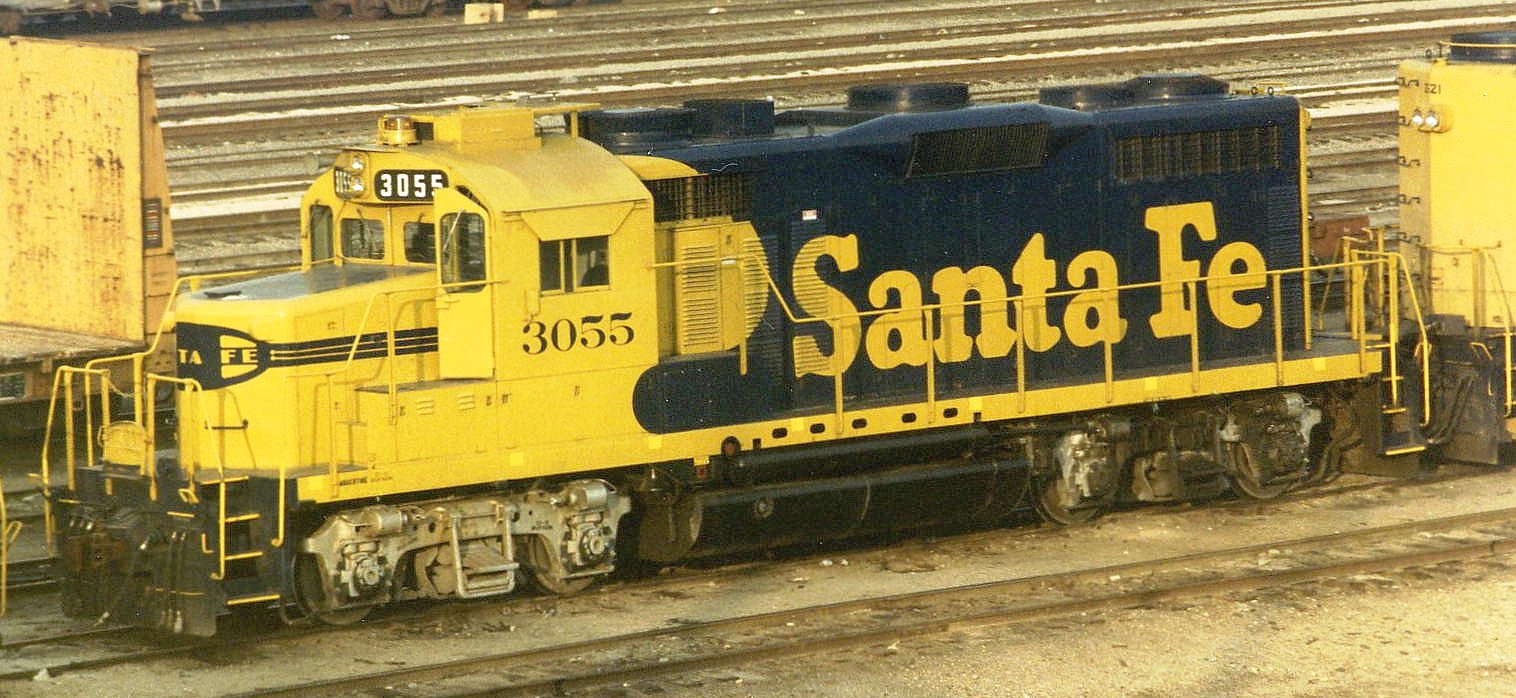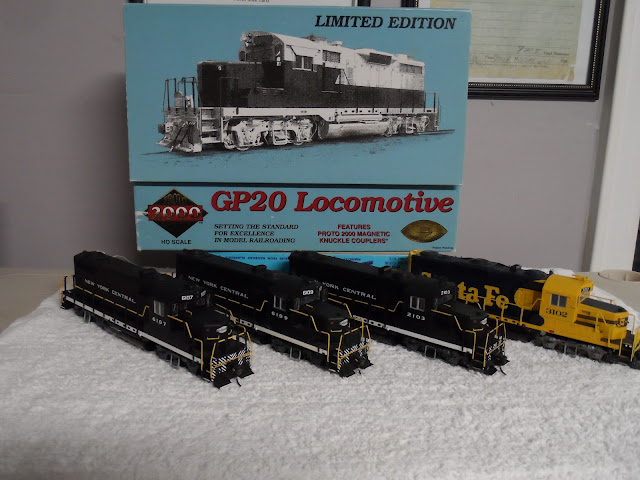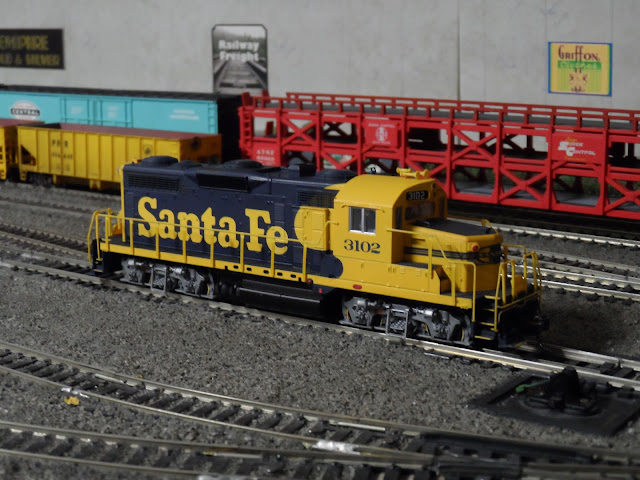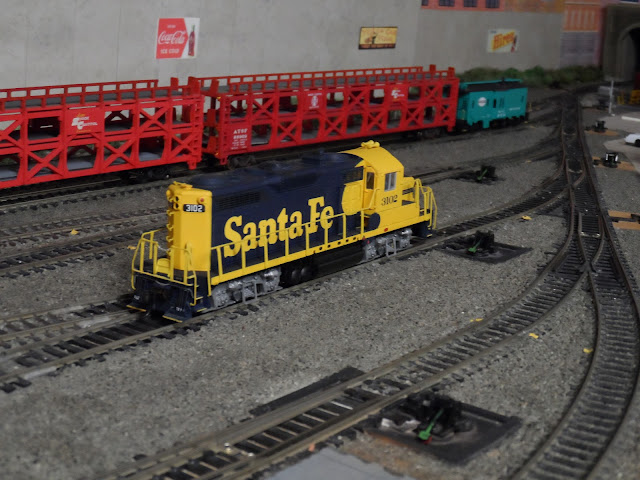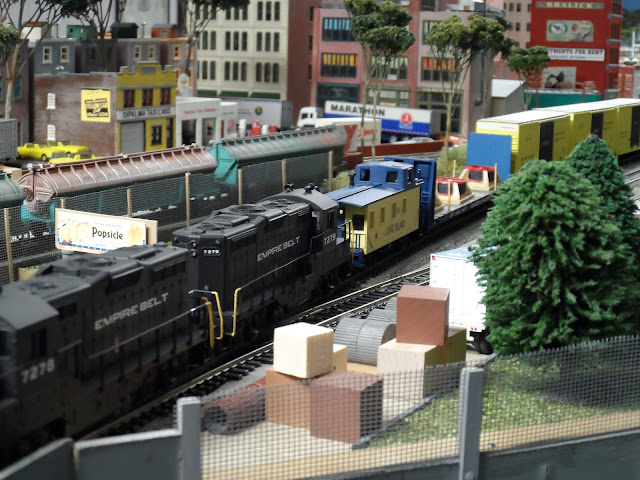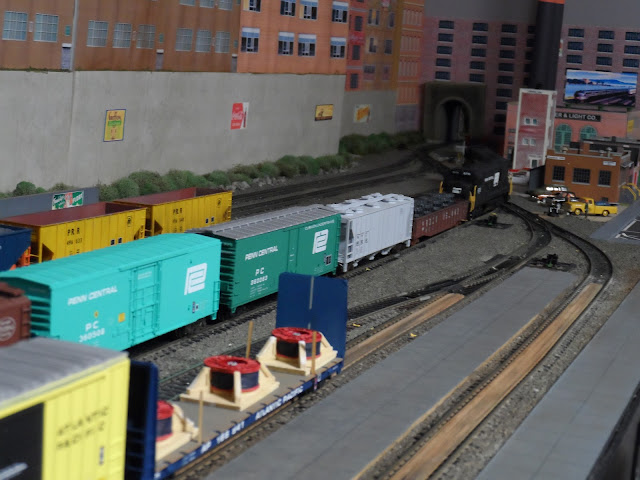Greetings All,
Welcome to another Locomotive Spotlight!!!
Todays spotlight will shine on the New York Central GP20s and we'll take a look at the prototype, the New York Central during this period and the 1:87 scale models in my locomotive fleet.
Prototype Information
Faced with dwindling sales after the steam to diesel transition of the 1940s and 1950s the General Motors Electro Motive Division (EMD) introduced the General Purpose GP20 in 1959. This locomotive featured many improvements while still keeping the basic 567 engine common to thousands of other EMDs already in service.
The idea that three new 2000 HP GP20s replacing four older 1500 HP cab units seemed obvious and the face of dieseldom changed once again.
EMD produced the GP20 from November 1959 thru April, 1962. The GP20 is a four axle, 2,000 horsepower road switcher that had sales of 260 units to eight class 1 railroads. The largest purchaser was the ATSF taking delivery of 75 units.
"File:ATSF 3055 19871200 CA San Bernardino.jpg" by Slambo at en.wikipedia is licensed under CC BY-SA 2.0. To view a copy of this license, visit https://creativecommons.org/licenses/by-sa/2.0/?ref=openverse.
The GP20 was the second EMD locomotive with a factory installed turbocharger following the six axle EMD SD24. The turbo charged EMD 567D2 prime mover in the SD-24 produced 33% more power than the SD-18 that utilized a Roots Blower. However the four axle GP20 only produced 11% more power than the similarly Roots Blower powered GP18 due to traction motor limitations at that time.
A CB&Q SD24 at an unknown location and date but looking very sharp.
"File:Burlington504.JPG" by WuhWuzDat is licensed under CC BY 3.0. To view a copy of this license, visit https://creativecommons.org/licenses/by/3.0/?ref=openverse.
EMD was reluctant to turbo charge the 567D2 prime mover that powered the EMD GP20 and was spurred on by the Union Pacific (30 units purchased) based on their own addition of a turbocharger to their GP9s. These engines would become known as Omaha GP20s.
New York Central
The New York Central was a class 1 railroad known for its great steel fleet and extensive passenger operations that included the famed 20th Century Limited. Unfortunately the Central's large post war investment in new passenger trains were causing the RR to hemorrhage money as highways and air travel took much of the post war travel and freight away from the NYC and the RR was in bad financial shape in the late 1950s and into the 1960s.
"New York Central System" by Phil Beard is licensed under CC BY-NC-ND 2.0. To view a copy of this license, visit https://creativecommons.org/licenses/by-nd-nc/2.0/jp/?ref=openverse.When RR president Al Perlman took over in 1954 after a nationwide slowdown and bitter proxy fight his first edict to reduce losses was to cut all new diesel locomotive orders in half erroneously thinking that more mileage could be squeezed out of the existing diesel fleet. This error in judgement would leave the NYC chronically short of locomotives as the economy improved.
In December 1960 car loadings were down 20.5% and down 1.9% for the year 1960. January 1961 didn't start out any better for the Central as car loadings were down 18.9% in January as compared to January 1960 and were down overall by 22.9% in the first quarter. For the fiscal year 1960 car loadings were down 11%. Year end revenue shows a net loss for the railroad of more than 12 million dollars.
New York Central GP20s
Cash strapped and chronically short of available locomotives the NYC purchased fifteen EMD GP20s in 1961 using a group of FTAs, FTBs, F3As and F3Bs as trade in allowances.
The New York Central's fifteen GP20s were unique in that they were the only GP20s erected without dynamic brakes. The GP20s would be unique to the RR as well ushering in their first low hood road switchers along with the fifteen Alco RS32s that were purchased during the same time.
The fifteen New York Central GP20s were delivered in the summer of 1961 classed by the NYC as DRS11 and numbered 6100-6114. Thirteen of the fifteen GP20s would make it to the Penn Central.
GP20 #6109 was wrecked in December 1963 and traded in for an EMD GP35.
GP20 #6106 was struck by an overhanging flexi-van in August 1965 and scrapped.
The NYC classification system was changed in 1966 for the pending merger with the PRR. The GP20s would be classified as an EF-20 locomotive. E-EMD, F-Freight, 20-2,000 HP.
The NYC thirteen remaining GP20s would be renumbered to 2100-2112 and they would carry this road number throughout their Penn Central careers and into Conrail.
PC 2107 in "pure form" rests at West Mill, NY on PC Ralph's Kings Port Division layout.
In 1972 the PC was enjoying the economy of the 2,000 HP non turbo charged GP38s and started removing the costly turbochargers from their GP20s. The 2107 remains turbo equipped on PC Ralph's Kings Port Division and is seen crossing Ulster Ave as it works the Kings Port Interchange Track.
The Models
My three NYC GP20s and one ATSF GP20 are the older pre Walthers Life-Like Proto 2000 Models.
Additional Thoughts and Comments
From their original date of purchase by the New York Central thru Penn Central and into Conrail the NYC GP20s proved to be reliable workhorses capable of leading the hottest symbol trains for the NYC or running heavy transfer freights in their later PC and CR years. Photographic evidence shows these GP20s remained in service with Conrail thru 1985.
The P-2000 models unfortunately suffered from the cracked axle gear syndrome that plagued so many of their models. If considering purchasing any of these models be mindful that you may have to factor in the changing of the gears.
On the plus side once the gears were changed they have run trouble free for 20 years with only some light maintenance like lubrication. Their heavy weight allows them to pull a good amount of tonnage and the short four axle wheelbase is perfect for my layout.
A double plus for me is that while putting this locomotive spotlight together I stumbled onto a really good looking and good running four GP20 lash up!!
NYC GP20s bring a train into Terminal Yard in 1962 and find their EMD catalog replacements, the GP30, on their demonstration tour.
Additional Reading
New York Central Railroad Color History by Brian Solomon with Mike Schafer
Penn Central Power by Robert J. Yanosey.
Penn Central System Bi-Annual by Robert H. Reid
Trains of the 1970s. Kalmbach Publishing.
Prototype Photos
Conrail GP20m #2103 passing thru Allentown PA in 1985
Thanks for reading and watching!!!
See you soon!!!


